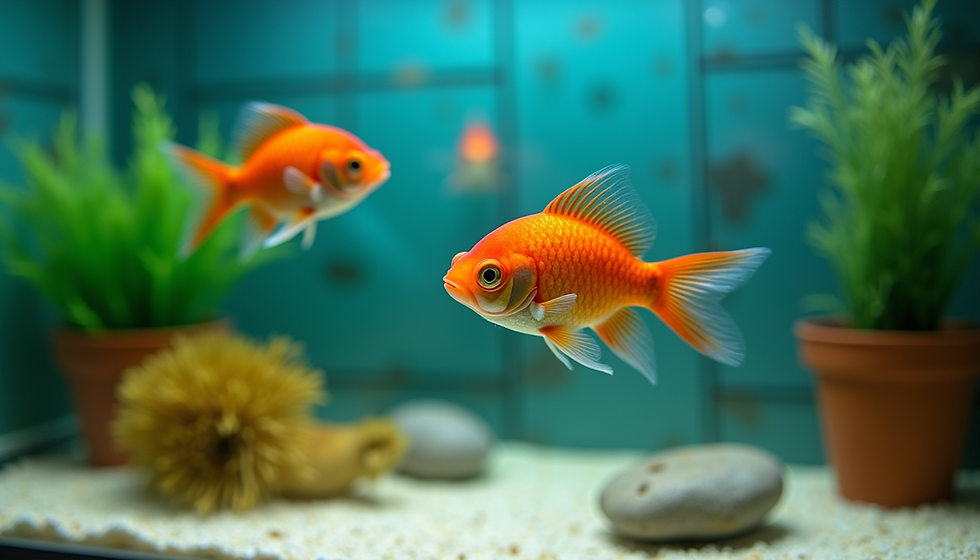How to Keep Your Aquarium Clean and Healthy
- John Wright-Ibarra

- Aug 7, 2025
- 4 min read
Keeping an aquarium clean and healthy is crucial for the well-being of your aquatic pets and the overall beauty of your tank. A well-maintained aquarium not only provides a safe environment for fish and plants but also enhances the visual appeal of your home or office. This guide will walk you through practical steps and expert advice on aquarium maintenance to ensure your underwater world thrives.
Understanding Aquarium Maintenance: The Basics
Aquarium maintenance involves regular tasks that keep the water quality high, the tank clean, and the aquatic life healthy. Neglecting these tasks can lead to algae overgrowth, unhealthy fish, and an unattractive tank. Here are the fundamental components of aquarium maintenance:
Water Quality Management: Regularly test water parameters such as pH, ammonia, nitrite, and nitrate levels. Maintaining the right balance is essential for fish health.
Water Changes: Replace 10-20% of the tank water weekly or biweekly to remove toxins and replenish minerals.
Filter Cleaning: Clean or replace filter media as recommended to ensure efficient filtration.
Gravel Vacuuming: Remove debris and uneaten food from the substrate to prevent waste buildup.
Algae Control: Scrape algae from the glass and decorations to keep the tank clear.
By following these steps consistently, you can prevent common problems and create a stable environment for your aquatic pets.

Close-up view of a clean aquarium with clear water and healthy fish
How to Perform Effective Aquarium Maintenance
Performing aquarium maintenance can seem overwhelming at first, but breaking it down into manageable tasks makes it easier. Here’s a step-by-step guide to help you maintain your aquarium effectively:
Test the Water
Use a reliable test kit to check water parameters. Ideal freshwater aquarium levels are:
pH: 6.5-7.5
Ammonia: 0 ppm
Nitrite: 0 ppm
Nitrate: below 20 ppm
Change the Water
Use a siphon to remove 10-20% of the water. Replace it with dechlorinated water at the same temperature to avoid shocking the fish.
Clean the Filter
Rinse filter media in removed tank water to preserve beneficial bacteria. Replace media only when necessary to maintain biological filtration.
Vacuum the Gravel
Use a gravel vacuum to remove waste trapped in the substrate. This prevents harmful buildup and keeps the tank environment healthy.
Remove Algae
Use an algae scraper or magnetic cleaner to remove algae from the glass. Clean decorations and plants as needed.
Inspect Equipment
Check heaters, lights, and pumps to ensure they are functioning properly.
Regular maintenance not only keeps your aquarium clean but also helps you spot potential issues early.

Eye-level view of aquarium filter and equipment being cleaned
What are People Who Keep Aquariums Called?
People who keep and care for aquariums are commonly known as aquarists. Aquarists range from hobbyists who maintain home tanks to professionals working in public aquariums or research facilities. Their knowledge and dedication are vital for the health of aquatic life.
Aquarists often specialize in different types of tanks, such as freshwater, saltwater, or reef aquariums. They understand the specific needs of various species and the importance of maintaining water quality, proper feeding, and habitat conditions.
If you are new to aquarium keeping, learning from experienced aquarists or consulting with professionals can be invaluable. For those seeking expert help, searching for aquarium services near me can connect you with specialists who offer cleaning, maintenance, and setup services.

High angle view of an aquarist adjusting aquarium equipment
Tips for Preventing Common Aquarium Problems
Preventing issues before they arise is key to maintaining a healthy aquarium. Here are some practical tips to avoid common problems:
Avoid Overfeeding: Feed fish only what they can consume in 2-3 minutes. Excess food decomposes and pollutes the water.
Do Not Overcrowd: Keep the number of fish appropriate for your tank size to reduce stress and waste.
Quarantine New Fish: Isolate new arrivals for 2-4 weeks to prevent introducing diseases.
Maintain Proper Lighting: Use a timer to provide consistent light cycles, usually 8-10 hours per day, to control algae growth.
Use Live Plants: Live plants absorb nitrates and improve water quality.
Regular Observation: Watch your fish daily for signs of illness or stress.
By following these tips, you can minimize the risk of disease, algae blooms, and other common aquarium issues.
Advanced Aquarium Maintenance: Beyond the Basics
For those looking to take their aquarium care to the next level, consider these advanced maintenance practices:
Deep Cleaning: Occasionally perform a more thorough cleaning by removing decorations and scrubbing them with aquarium-safe tools.
Water Chemistry Adjustments: Use buffers and supplements to maintain stable pH and hardness levels tailored to your fish species.
CO2 Injection for Planted Tanks: Enhance plant growth by adding CO2 systems.
Automated Systems: Invest in automatic feeders, water changers, and monitoring devices to simplify maintenance.
Regular Health Checks: Conduct parasite screenings and water tests more frequently for sensitive or high-value species.
These advanced techniques require more knowledge and equipment but can significantly improve the health and aesthetics of your aquarium.
Maintaining a clean and healthy aquarium is a rewarding hobby that requires commitment and care. Whether you are a beginner or an experienced aquarist, following these guidelines will help you create a thriving aquatic environment.
For professional assistance, consider reaching out to aquarium services near me to ensure your tank receives expert care.
By implementing these aquarium maintenance strategies, you can enjoy a vibrant and healthy underwater ecosystem that brings joy and tranquility to your space.





Comments